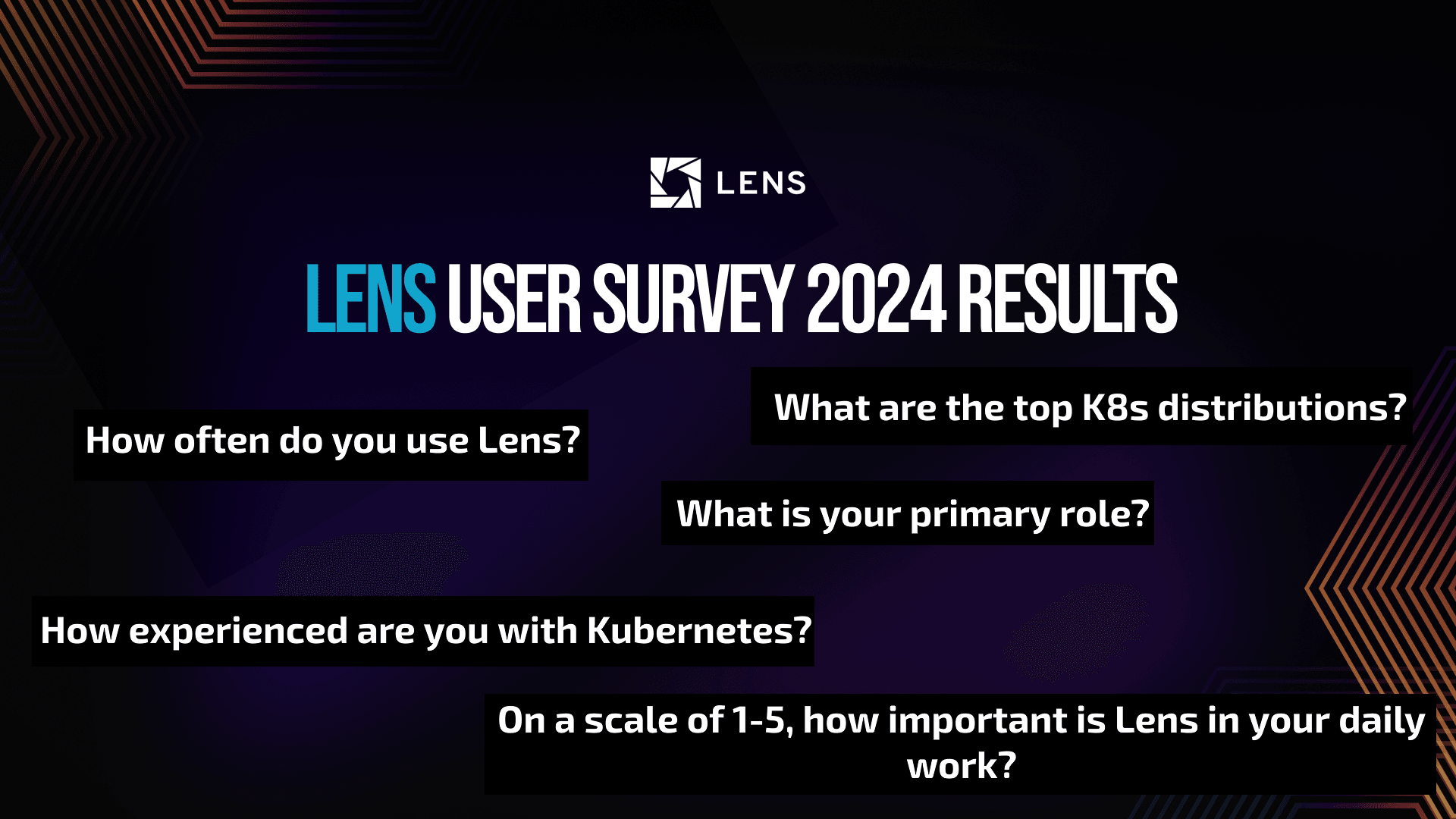Lens User Survey 2024: The Voice of Our Community
At Lens we care deeply about our community, and as we prepare the launch of a new annual user survey, we want to share last year’s results and how they’ve influenced our experience over the past year. Each of your responses gave us direction, inspiration, and a clearer sense of what you need the most from Lens and the Kubernetes (K8s) ecosystem. We want to make Lens even stronger for the entire community, and your voice matters.
Right now, we are working on many improvements to our product, and at the same time, we are focusing on building a new annual survey, this time more focused on the Kubernetes ecosystem. We will share the new survey as soon as it is ready, but in the meantime, if you want to offer feedback, please use our Lens Forums.
Now let's jump into the results of our last year’s survey. If you want to see the 2023 user survey, check out this article.
TL;DR?
Who Is Using Lens Kubernetes IDE?
Kubernetes is becoming more and more adopted, and with it, there are many tools that evolve at the same time to keep up with the community’s needs, and Lens Kubernetes IDE makes no exception. If you want to see a list of the best Kubernetes tools to use in 2025, check out this article.
We saw that we have the same diversity in roles, experience, and company sizes that we had last year as well, which shows that Kubernetes keeps evolving at a powerful pace.
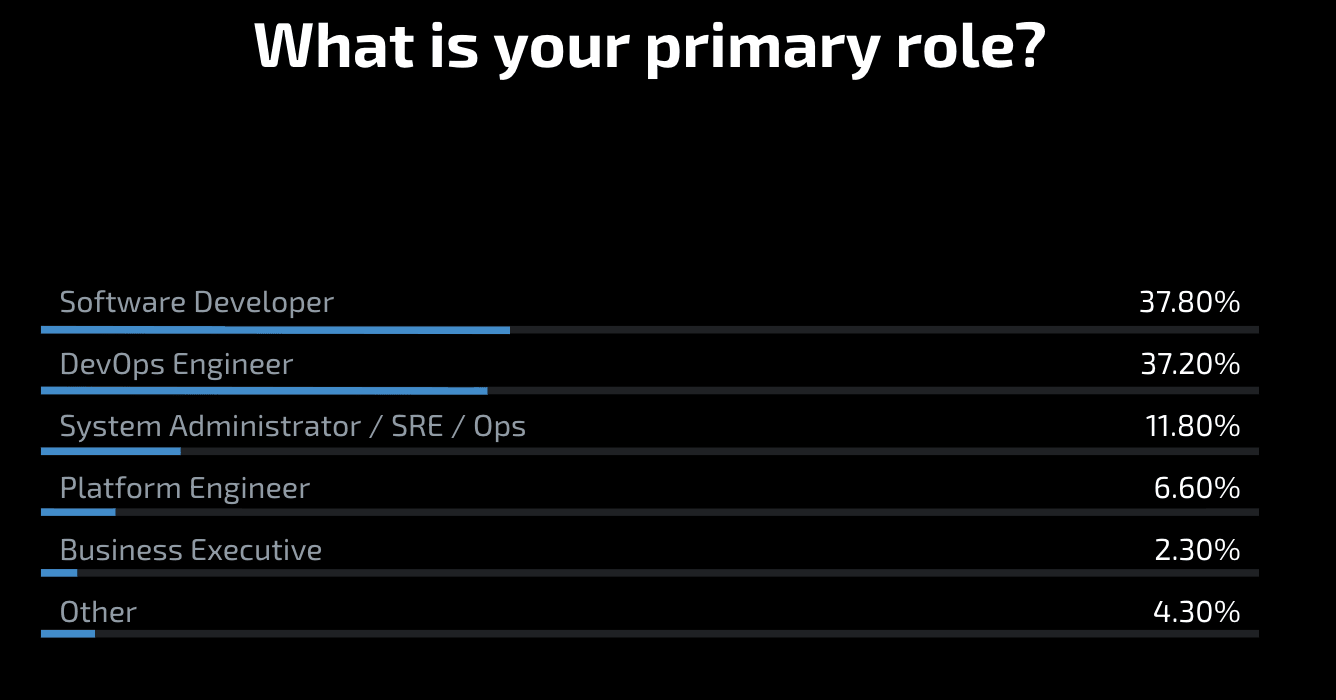
Let’s explore the results:
- 37.8% of our Lens Users are Software Developers – The evolution of microservices and cloud-native technologies makes Lens Kubernetes IDE a natural choice for everyone that develops software in this area. Lens Kubernetes IDE helps our developers navigate complex Kubernetes environments with ease, so they can focus on what really matters: building new applications and features, without being slowed down by infrastructure complexity. When compared to last year’s results, we can see that we have a 4% reduction in the number of software developers, and we will show you where these numbers went.
- 49% are DevOps Engineers/Sys Admins/SRE/Ops – Almost half of our user base sits at the operational level. The rise of IaC, GitOps, AI, and Kubernetes operators, makes Lens Kubernetes IDE a perfect choice for ensuring that all systems stay reliable, scalable, and secure. For this user group, Lens provides powerful observability and management features, reducing the friction in daily operations, and making it easy to enable smoother collaboration. When compared to last year’s results, we can see a 4% increase in the number of users using Lens Kubernetes IDE, making it clear that these systems have to be more reliable than ever to satisfy the demanding needs of the cloud native ecosystem.
- 6.6% are Platform engineers – Platform engineering is usually tasked with designing and maintaining internal developer platforms. Lens Kubernetes IDE supports them by offering a more consistent and friendly way to provide Kubernetes as a service internally. By using Lens K8s IDE you can bridge the gap between platform infrastructure and developer productivity. Since last year, we see a 0.4% increase in our platform engineering users, and even though it doesn’t seem too much right now, we can surely expect greater numbers in the future.
- 2.3% are Business executives – Business executives are a small portion of our audience, but it's clear that they are interested in understanding the strategic value of Kubernetes investments. Lens Kubernetes IDE helps business execs get visibility into the ecosystem, making it easier for them to align technology decisions with business outcomes. We saw a 0.5% decrease in this category, but still, having over 2% means that execs are serious about understanding what Kubernetes offers, and how it supports the broader shift to cloud-native
What is your organization size?
Lens Kubernetes IDE adoption isn’t limited to a specific organization size. It is used at every level from solo developers/DevOps engineers working on passion projects or trying to learn a new skill, to large enterprises that are running missions critical workloads.
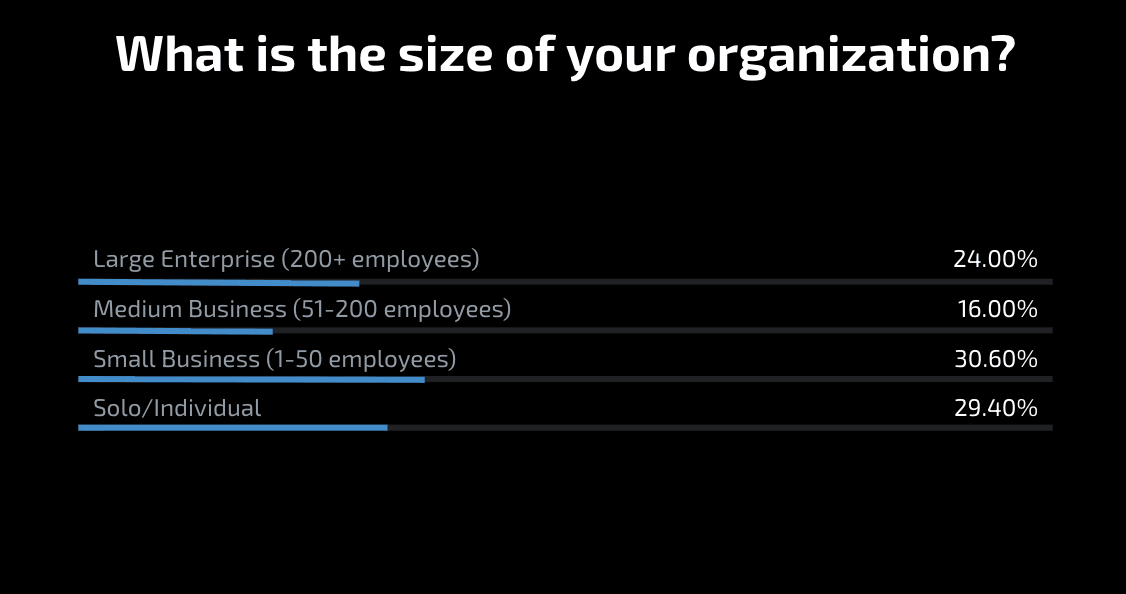
Let’s explore these results:
- 29.4% of our users are solo developers/DevOps or individual consultants – Many of our users are independent developers, consultants, or learners who use Lens K8s IDE to simplify Kubernetes and accelerate their personal projects. This enforces the idea that Kubernetes is no longer an enterprise game, and it can be accessed at any level. Lens K8s IDE removes the steep learning curve, transforming Kubernetes into something more approachable. When compared to last year’s results, we can see a 2.5% drop in solo users.
- 30.6% of our users work in Small businesses (1-50 employees) – Startups and small teams often operate with limited resources but they have high agility. Adopting Kubernetes from the beginning is driven by its flexibility and scalability it provides, making it easier to grow, and reducing the overall technical debt. Lens Kubernetes IDE empowers these users to manage production K8s environments without heavy overhead, allowing them to stay lean, while scaling with confidence. Compared to last year, we see a 0.3% drop in small business, and based on our results we understand that this happen because they matured to medium businesses
- 16% of our users work in Medium businesses (51-200 employees) – At this stage, Kubernetes environments mature, teams are growing, and infrastructure becomes more complex. These users go from managing a handful of clusters to tens/hundreds of them. With Lens Kubernetes IDE managing these clusters becomes efficient, users get more clarity, and collaboration becomes streamlined. When comparing to last year’s results, we observe a 2.5% increase in Lens adoption at the Medium business level which easily translates to companies increasing their value
- 24% of our users work in Large enterprises (200+ employees) – At the enterprise level, you will usually manage hundreds/thousands of Kubernetes clusters often across hybrid, edge, and multi-cloud setups. Large enterprises are working with Kubernetes to modernize their legacy infrastructure, and transform their monolith applications into microservices. Lens Kubernetes IDE helps enable these organizations to centralize their cluster management, enforce Kubernetes best practices at scale, and empower their engineers with an intuitive interface. When compared to last year, we notice a 0.6% increase in our enterprise users.
Based on these results and their board distribution, it is clear that Kubernetes is accessible for any organization level, and its adoption has far reached beyond early adopters. Kubernetes has become a standard across the entire industry, and many organizations are leveraging it to drive innovation, efficiency, and scalability. Lens Kubernetes IDE plays a critical role in making Kubernetes approachable and valuable at all organization sizes.
What is your experience with Kubernetes?
Our users have different experience levels, and based on the results we are seeing, it is clear that Lens Kubernetes IDE can help you at any level you are. This diversity shows us clearly that Kubernetes is becoming more and more adopted by organizations, and more and more engineers have started to use it.
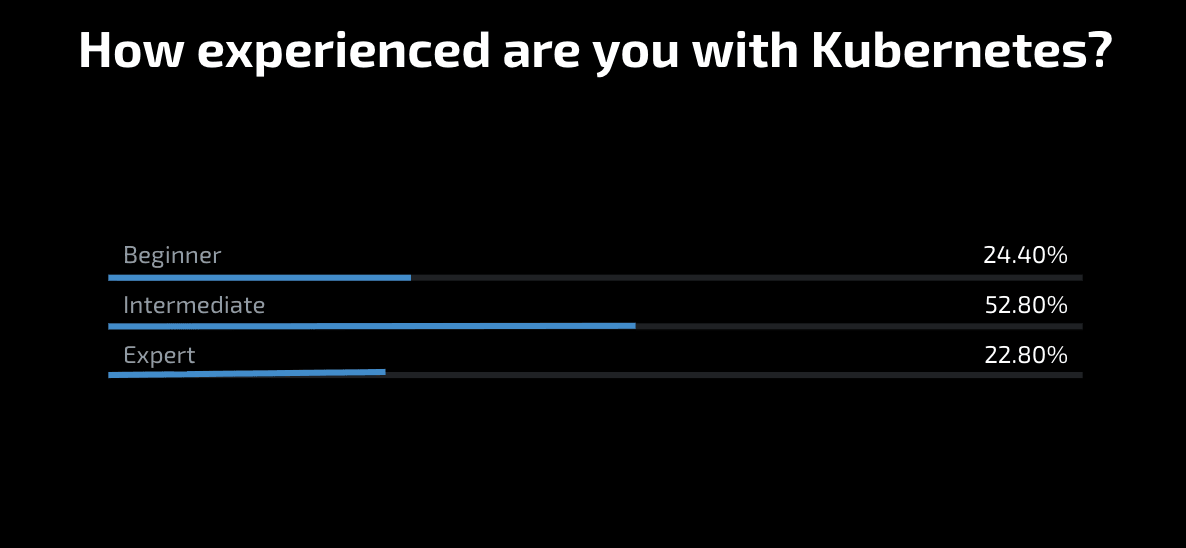
Let’s see what is our user’s experience:
- 24.4% of our users are beginners – A quarter of the community is just starting their Kubernetes journey. When compared to last year, there is a 6.6% drop in beginner users which means they are now intermediate. At the beginner level, Lens Kubernetes IDE provides an accessible entry point, removing the steep learning curve and complexity while enabling quick wins. Lens K8s IDE offers an intuitive UI, simplified cluster management, and by leveraging Lens Prism, our new AI assistant, new users can get the help they need in order to increase their skill levels, without getting lost in complexity.
- 52.8% of our users are intermediate – The majority of our users are intermediate, which brings us at a 3% increase when compared to last year’s results. This group is accustomed to using Kubernetes in their day-to-day activities. For this group Lens Kubernetes IDE helps them deepen their skills with advanced insights, AI analysis with Lens Prism, one-click integration for AWS EKS, and other productivity features. With Lens K8s IDE, these users move towards optimizing their clusters and implementing best practices
- 22.8% of our users are experts – Another quarter of users are seasoned Kubernetes practitioners, who are often responsible for running mission-critical workloads. Compared to last year, we see a 3.6% increase in this category, which makes it clear that Lens Kubernetes IDE proves its value by reducing operational overhead, centralizing Kubernetes management across multiple clusters, and providing the observability and control needed to run production environments efficiently
The increase in intermediate and experts shows clearly that Lens Kubernetes IDE is not only helping beginners, but seasoned engineers all together. It doesn’t matter where you are in your Kubernetes journey, Lens will still grow with you.
How did you hear about Lens Kubernetes IDE?
It’s interesting to see how people first heard about Lens Kubernetes IDE, and we can easily see that our growth has been driven by you, our community.
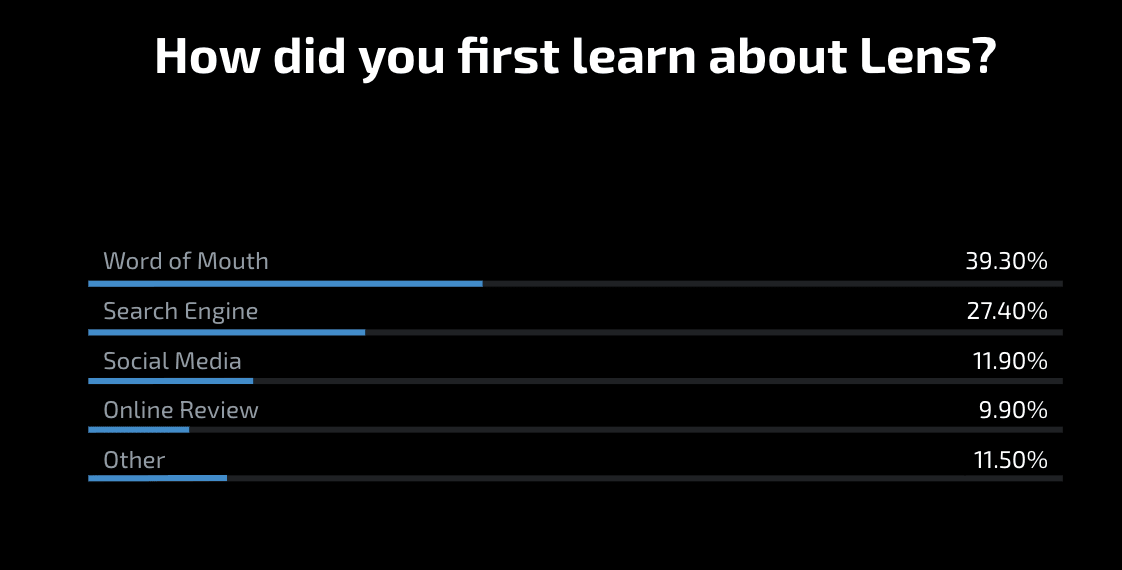
When comparing the above results with last year’s we can see that our trends are similar. The majority of our users have learned about Lens through word of mouth, and that’s something we are really proud of. The cloud native community constantly validates Lens Kubernetes IDE, and showcases that we are delivering real value to our users.
Search engines and social media are another important part in learning about Lens Kubernetes IDE, summing up almost the same numbers as word of mouth. As you go to search engines to figure out issues in the Kubernetes ecosystem, we are constantly there through our community, blog, YouTube channel, and forums to help solve the problems you might have. Platforms like LinkedIn and X, enable us to share with you insights into what is happening in the Kubernetes landscape, and what is new with Lens Kubernetes IDE.
Lens Kubernetes IDE’s presence in all of these channels ensures that we meet you wherever you are, whether you are searching for technical solutions, engaging with other peers in the community, or staying updated on the latest trends in cloud native development. By being visible and active across search, social, and community-driven space, Lens Kubernetes IDE is able to support you at any stage you are to get the most out of your Kubernetes experience.
How often do you use Lens?
Based on the results of our survey, we can proudly say that our tool is really used by our community, and it became an essential part of your Kubernetes journey. If you want to see what you can do with Lens Kubernetes IDE, check out this article.
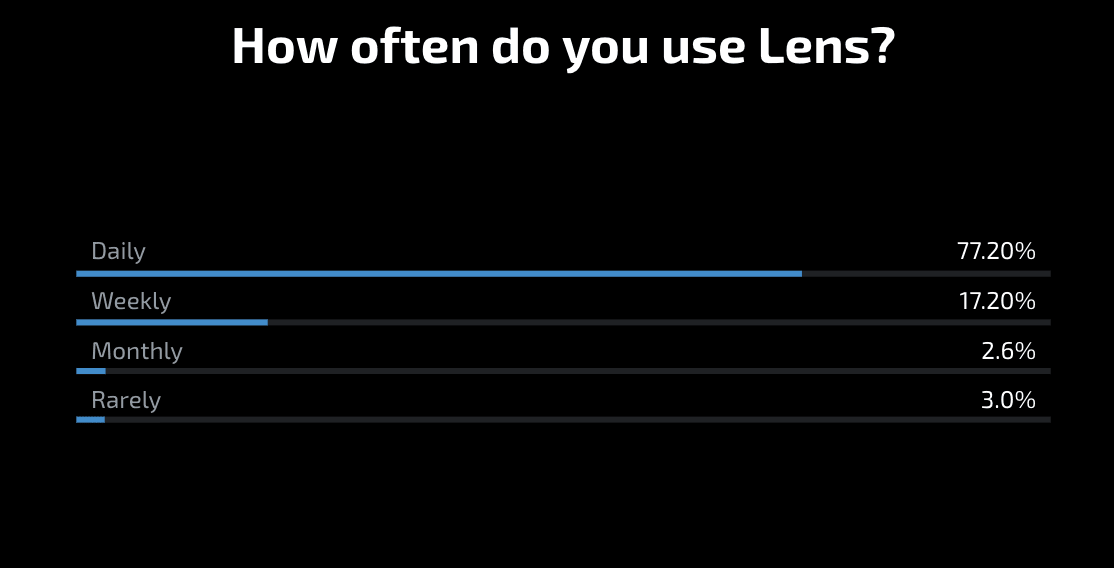
Let’s talk about the results
- 77.2% of our users report using Lens daily – This is more than 3 quarters of the total number of users, and compared to last year, it is a 3% percent bump. Having this daily engagement highlights how Lens Kubernetes IDE has become integrated in your workflows. It is your everyday companion for managing and navigating Kubernetes.
- 17.2% of our users utilize Lens weekly – For this group, Lens Kubernetes IDE serves as a reliable assistant when Kubernetes tasks require it. In this category we saw a 2.5% drop since last year, meaning that these users have become daily users in the past year.
- Less than 6% of our users are leveraging Lens monthly or rarely – This small percentage reflects users who might be experimenting, are just starting their Kubernetes journey, or working in environments in which Kubernetes is not their primary focus.
Over 94% of our user base leverage Lens Kubernetes IDE on a daily or weekly basis which means that our tool is something you rely on, consistently and frequently. Lens K8s IDE is playing a meaningful role in your Kubernetes journey, so we want to thank you for your trust.
How important is Lens to your daily work?
It is clear that Lens Kubernetes IDE has become essential to the daily work of cloud-native developers, DevOps engineers, operations teams, and platform engineers.
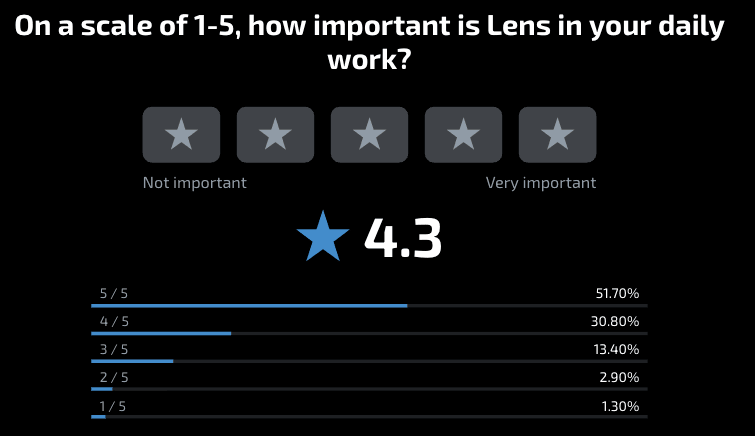
51.7% of users have rated Lens as a 5/5 – More than half of our community have rated Lens Kubernetes IDE as absolutely essential to their work. It is clear that for more than half of you, we are delivering on our promise to simplify Kubernetes management and empowering you to focus on innovating rather than fighting complexity.
- 30.8% of users have rated Lens as 4/5 – Nearly a third of our users consider Lens K8s IDE highly important, showcasing that we add value to their workflows. For this group, Lens K8s IDE has become a trusted partner in the Kubernetes ecosystem, making cluster management more efficient and accessible. Since last year, Our 5/5 importance got a 4.9% decrease, but this category got an almost 6% increase which indicates that while fewer users consider Lens absolutely indispensable, more users now see it as a highly important and reliable tool in their daily Kubernetes workflows.
- 13.4% of users have rated Lens as 3/5 – This group recognizes Lens Kubernetes IDE as helpful, but not yet indispensable in their day to day operations.
- The remaining 2.9% and 1.3% have rated Lens as 2/5 and 1/5 – While small in numbers, these voices are equally important, as they remind us that Kubernetes use cases vary widely. We take these inputs seriously and continue to refine Lens Kubernetes IDE’s experience for all types of users.
Overall, more than 82.5% of our users have rated us 4 or 5 out of 5, meaning that there is a strong foundation of trust and reliance on Lens Kubernetes IDE. When compared to last year, 81.6% rated us the same, so the growth is almost 1%. This validates our mission, while motivating us to close the gaps and transform Lens Kubernetes IDE into a more indispensable tool in the Kubernetes community.
How your voice has influenced the product
Last year you gave us so much constructive feedback and this year has been no different. Here are some the suggestions you gave us, that we’ve implemented since:
- The ability to export data from various views – you can now do this from almost all the views
- Enhanced filtering – We’ve introduced Contextual Tab Filtering, and more features around filtering and insights will be coming to the product in the future
- Additional integrations to expand functionality and improve workflow efficiency – we’ve released the one-click AWS integrations, Lens Prism, our new AI assistant, and support for OCI Helm registries
We heard from many of you how valuable the Hotbar was for quick access to multiple clusters, and its removal in the new UI/UX at the end of 2024 didn’t go unnoticed. We’ve listened to your feedback and we’ve added the Hotbar back shortly after it got removed. In the next Lens updates, it will be redesigned to work seamlessly with Contextual Tab Filtering.
These are some of the priorities you’ve highlighted this year:
- Add an AI assistant, and more AI capabilities (AI agents) – We’ve heard you loud and clear on this one, and that’s why we’ve released Lens Prism and we are working on improving it and adding more capabilities
- Bulk and batch actions – you want to be able to control more resources at the same time from the UI (redeploy multiple workloads, suspending or resuming several cronjobs at once, etc)
- Search and filtering – you want to be able to better filter your resources, and to save these filtered views for later access
- Multi-cluster/Multi-window – you would like to view multiple clusters side by side, to make it easy to compare resources in different clusters
- Integrations and extensibility – Lens Kubernetes IDE has always been a hub to your Kubernetes workflows, but you want to connect more with other tools from the ecosystem.
We’ve been listening closely, and your feedback is already shaping the future of Lens Kubernetes IDE. Your top suggestions will always be our priority, and the rest will be added in the next wave of improvements.
Our community has always been at the heart of our progress. You made us understand what is working well, what we can improve, and what is not working, and you told us what features make and would make your Kubernetes experience more enjoyable.
Top Kubernetes distributions in 2024
Based on our statistics, Lens Kubernetes IDE has worked with hundreds of thousands of clusters in 2024, supporting millions of users worldwide.
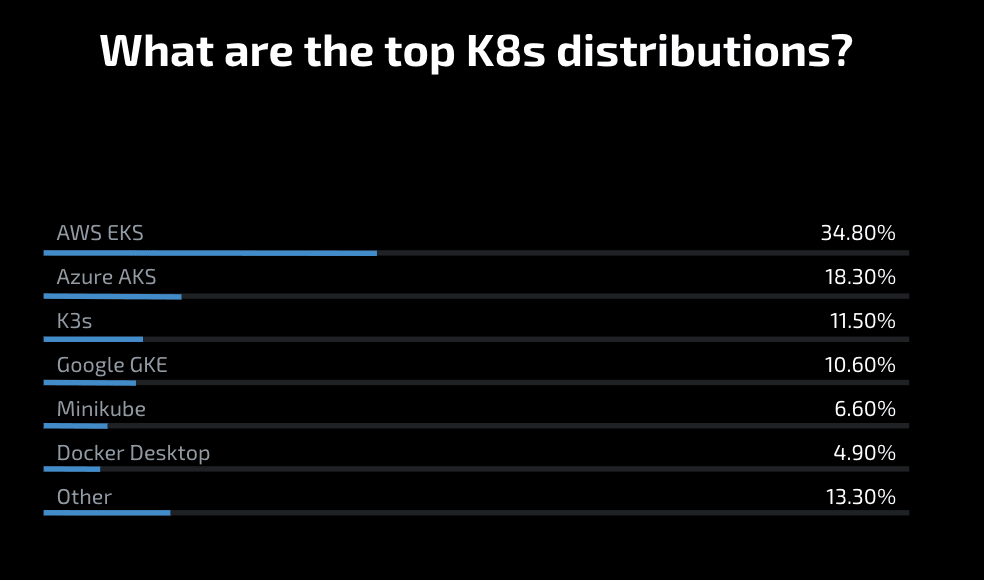
Almost 35% of these Kubernetes clusters were AWS EKS, 19% were Azure AKS, and 11% were Google Kubernetes Engine (GKE). More than half of the clusters we’ve seen are in the top three cloud providers, which highlights the strong preference for managed Kubernetes solutions, especially in enterprise organizations.
k3s sums up almost 12% of the Kubernetes clusters used, which means that our users are really looking into lightweight distributions as well.
Minikube and Docker-desktop based clusters sum up to almost 12% of the clusters, meaning that even in small development environments, Lens Kubernetes IDE is really helpful.
12 Top Kubernetes applications in 2024
These are the top applications used in Kubernetes in 2024::
1. ingress-nginx
2. cert-manager
3. Grafana
4. aws-node
5. aws-ebs-csi-driver
6. kube-state-metrics
7. metrics-server
8. aws-load-balancer-controller
9. redis
10. aws-cluster-autoscaler
11. argocd-applicationset-controller
12. lens-metrics
We see a strong preference for ingress-nginx, cert-manager and Grafana. This trend reflects the maturity of Kubernetes operations, where organizations are prioritizing reliable ingress controllers, automated certificate management and rich observability.
Because almost one third of the clusters are on AWS EKS, we see AWS related applications being really popular such as aws-node, aws-ebs-csi-driver, aws-load-balancer-controller and aws-cluster-autoscaler.
Kube-state-metrics, lens-metrics, metrics-server, are widely adopted for observability and monitoring, as they provide the data pipelines and resource metrics that integrate seamlessly with Prometheus and Grafana.
Argocd-application-controller and redis strong adoption demonstrate the traction of GitOps and stateful applications in the Kubernetes ecosystem. ArgoCD has become the de facto choice for GitOps in Kubernetes, while Redis is favored as a cache or as a lightweight, high-performance database.
The Kubernetes community is still experimenting, learning, and working on the best practices for managing clusters at scale, and this is exactly why your perspective is invaluable right now.
We need your voice to shape the Future of Lens and to influence the Future of Kubernetes
We are more than excited to announce our brand-new 2025 Kubernetes User Survey, that will help you understand what is working in Kubernetes, why, where the ecosystem is headed, and how we can improve Lens Kubernetes IDE to minimize these gaps.
By participating in this survey, you will:
- Highlight the gaps and challenges in the Kubernetes adoption processes and daily use
- Understand what is the current shape of the Kubernetes ecosystem
- Shape the roadmap of Lens Kubernetes IDE with your insights
- Contribute to the community by sharing real-world experiences
- Help us prioritize features that will make Kubernetes more manageable
This survey will be available directly in the Lens Kubernetes IDE application, so keep an eye out for an invitation in the following days.
We believe that together, with your voice, we can reduce friction, boost developer productivity, and set the foundation for the next generation of Kubernetes tooling.
